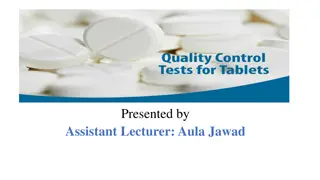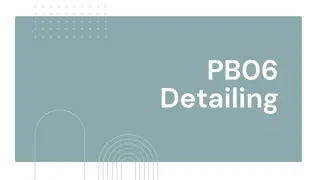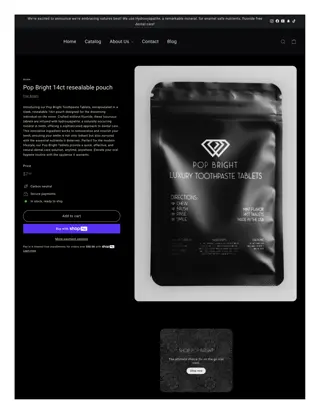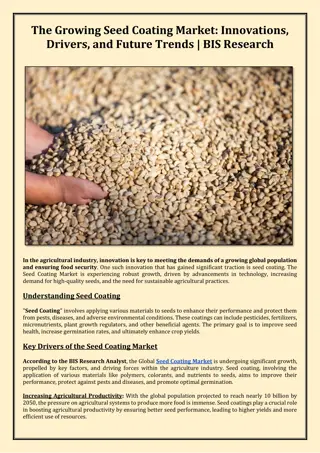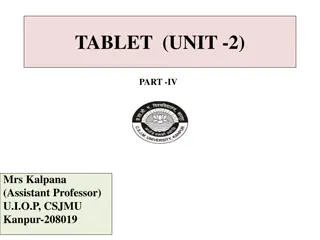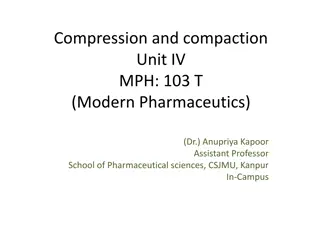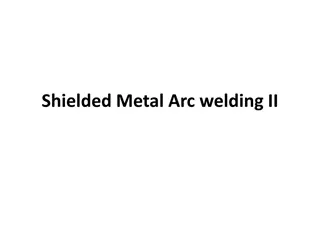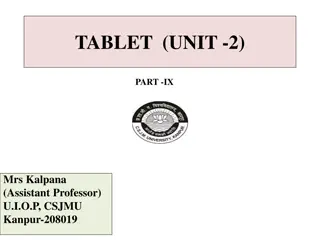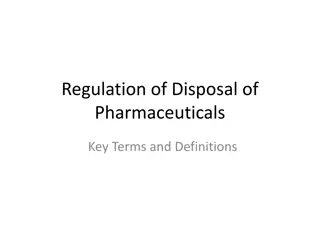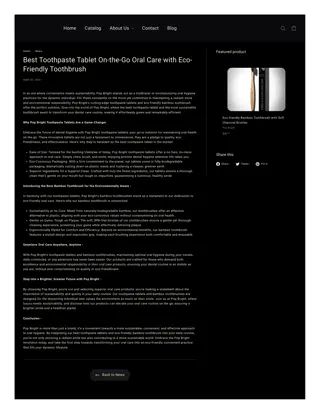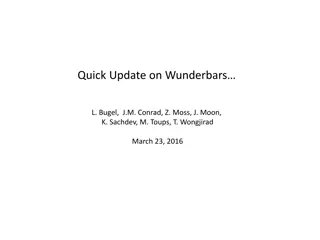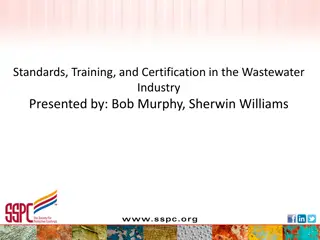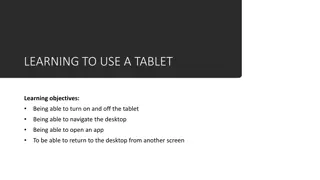Understanding Film Forming Agents for Tablet Coating in Pharmaceuticals
Film forming agents play a crucial role in tablet coating, providing mechanical strength and desired film characteristics. Non-enteric film formers like HPMC, MHEC, EC, HPC, Povidone, SCMC, and PG Acrylate Polymers are commonly used for uniform film formation. Each agent has unique properties and preparation methods, influencing the coating's efficacy and performance. Understanding these agents is essential for pharmaceutical formulation development.
Download Presentation

Please find below an Image/Link to download the presentation.
The content on the website is provided AS IS for your information and personal use only. It may not be sold, licensed, or shared on other websites without obtaining consent from the author. Download presentation by click this link. If you encounter any issues during the download, it is possible that the publisher has removed the file from their server.
E N D
Presentation Transcript
TABLET (UNIT -2) PART -VIII Mrs Kalpana (Assistant Professor) U.I.O.P, CSJMU Kanpur-208019
FILM FORMING AGENTS The film forming agents tablet coating are classified into: 1.Non - enteric film formers 2.Enteric film formers. NON-ENTERIC FILM FORMERS They are incorporated to give uniform film with desired mechanical strength which are as follows HPMC(Hydroxy propyl methyl cellulose) MHEC(Methyl hydroxyl ethyl cellulose) EC(Ethyl cellulose) HPC(Hydroxy propyl cellulose) POVIDONE SCMC (Sodium carboxyl methyl cellulose) PG ACRYLATE POLYMERS
HPMC It is prepared by reacting alkali treated cellulose with methyl chloride with propylene oxide. As it forms bridging & rough tablet surface, it has to be mixed with other polymers or plasticizers. MHEC It is prepared by reacting alkali treated cellulose with methyl chloride & then with ethylene oxide. It has similar properties as that of HPMC. But it is soluble in fewer organic solvents, it is not used as frequently as HPMC.
EC (Ethyl Cellulose) It is manufactured by the reaction of ethyl chloride with cellulose dissolved in NaOH. It is available in different viscosity grades. Unplasticized EC forms brittle films & requires film modifiers to obtain acceptable film. It is water insoluble & thus Cannot be used alone for tablet coating. It is usually combined with water Soluble additives E.g- HPMC to prepare film with reduced water soluble Properties & this combinations are widely used in sustained release coating
HPC(Hydroxy propyl cellulose) It is manufactured by the treatment of cellulose with NaOH followed by the reaction with propylene oxide at Elevated temperature and pressure. It forms tacky films. Used in combinations with other polymers to improve film characteristics. It is soluble in water (below 40 c & insoluble above 45 ?) , GI fluids & in many polar Organic solvents. POVIDONE It is synthetic polymer consisting of linear 1-vinyl-2- pyrrolidinone groups. It gives clear, glossy, hard films when dry. It give tacky films which can be overcome by plasticizer or other polymer.
ACRYLATE POLMERS These are marketed under the trade Name of Eudragit. Eudragit RL & RS are copolymers of Acrylic and meth acrylic acid esters. These films produce pH independent, delayed actions. Preparation is similar to that of EC formulations.
ENTERIC FILM FORMERS Purpose: To protect acid-labile drugs from gastric fluid e.g. Enzymes & certain Antibiotics. To prevent gastric distress or nausea due to irritation from the drug . e.g., Sodium salicylate. To deliver drugs intended for local Action in the intestines, e.g. Intestinal antiseptics. To deliver drugs that are optimally Absorbed in the small intestine to their primary absorption site. To provide a delayed-release component for repeat-action tablets.
PROPERTIES OF AN IDEAL ENTERIC COATING MATERIAL Resistance to gastric fluids. Susceptibility or permeability to intestinal fluids. Compatibility with most coating solution components & the drug substrates. Stability alone and in coating solution. The film should not change on aging. Formation of a continuous film, nontoxicity, with low cost. Ease of application without Specialized equipment. Ability to be readily printed and allow film to be applied to debussed tablets.
ENTERIC FILM FORMERS CAP(Cellulose acetate phthalate Acrylate polymers HPMCP( Hydroxypropyl methyl cellulose phthalate) PVAP(Polyvinyl acetate phthalate) CAP It is widely used. As it is hygroscopic and relatively permeable to moisture and gastric Fluids, film formed are brittle and hence formulated with hydrophobic- Film forming materials to achieve better enteric films. Aquateric coating is a reconstituted colloidal dispersion of latex particles. It is Composed of solid or semisolid polymer spheres of cap ranging in size from 0.05-3 Microns with an a average particle size of 0.2 microns.
ACRYLATE POLMERS Two forms of commercially available Enteric acrylic resins are Eudragit L and Eudragit S. Eudragit l is available as an organic Solution, solid or aqueous dispersion. Eudragit s is available only as an organic solution and solid. Eudragit l & s are soluble in intestinal Fluid at pH 6&7. HPMCP It is derived from HPMC by esterification with phthallic anhydride. These are stable than cap and dissolve At lower pH compared to cap and acrylate polymers. The solubility characteristic may result in Higher bioavailability of some specific drugs. It is available in various grades- HP55,HP50 etc. PVAP It is manufactured by the esterification of partially hydrolyzed Polyvinyl alcohol with phthallic Anhydride.


